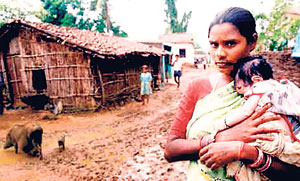I have no doubt that the financial meltdown has not affected India as much as it has other world economies. Industry is looking up. And so are some other sectors. The overall scene holds hope. Yet, the answer to the question I am seeking is: Why poverty in India is so indelible that the hike in economy, 7 to 9 percent for the last seven-eight years, has had little impact on the living standards of roughly the lower two-thirds?
Our GDP has more than quadrupled since 1950, from 8.4 per cent to 39.1 per cent. But the needle of poverty line is stuck more or less at the same point where it has been for many years. It is not coming down. Again, the per capita income has increased from Rs. 5,708 to Rs. 25,494, more than four times, but without changing the fate of some 40 crore people who are worse than before because the prices have soared beyond proportion.
Economic surveys and budgets mean little when there is no dent in poverty.
The big talk that India is being taken to Bharat is empty because not even half of the villages in the country have electricity and those which have do not get it for days. Water is a long haul. Doctors and teachers are becoming a rare sight in rural areas, although the claims made by the centre and the states about providing education and health facilities are increasing day by day.
Still more shocking is the report of a government panel, recommending that 50 percent of India’s population should be given below poverty-line cards, which entitle its holders cheap food grain. That means 50 percent of India’s population is still below the poverty line, that is, the earning is less than $2 (Rs 90) a day. But even these figures would not have been available if the Supreme Court had not appointed its own committee, headed by Food Commissioner N.C.Saxena, to find out the veracity of the government claims. The Planning Commission still places the line of poverty at 28.5 per cent. However, the recent Arjun Sen Gupta committee report says that 70 percent of the country’s population does not earn more than $2 a day.
Apart from the discrepancy, the ever-growing dilemma is where has the additional money earned or earmarked by the government gone? There are two possibilities. One is that the lower middle class has become the upper middle and the upper middle class has become the elite rich. But the fact is that the rich have become richer. The Forbes magazine, which regularly lists the top rich people in the world, is having more and more Indians among the first 15.
The other possibility is the reality. The amount which travels from the government in the shape of cash or food grains gets reduced to a trickle when it reaches the supposed beneficiaries.. There are too many middlemen and too long the transmission line which do not let the benefits flow freely and reach the targeted people. Former Prime Minister Rajiv Gandhi said that only 15 per cent of the allocations got to the people for whom they were meant.
The proliferation has gone up. No amount of effort, if exerted, has made little difference. The 15 percent appears to have got reduced to 12 per cent and the share of the poor is decreasing constantly. Take ration-card holders. They do not get food grain prescribed for them. The shopkeepers, part of a long chain of corrupt paraphernalia, do not give them full rations or say that they have not received them from the government. Rice, wheat or kerosene oil is diverted to the black market. This is purchased by the haves.
The entire system is creaking with corruption. The government machinery does not work until you grease it and it has to be done at every step. It is easy to say that those who offer graft are equally to blame. But their problem is that they cannot go ahead without bribing the horde of babus.
 |
| India’s remarkable economic growth has not alleviated rural poverty.
Pic anonlineindia.com |
There is need to appoint a high-power commission to find out where the extra money has gone. Thousands of crores of rupees have been allocated to the aam aadmi programmes. But everybody knows that this money has not reached the right quarters. After the completion of two Five-Year Plans, Prime Minister Jawaharlal Nehru was pilloried in Parliament that despite the increase of 42 percent in national income, the living conditions of the poor had remained the same. He appointed a committee headed by a progressive P.C.Mahalanobis to find out the answer.
The committee found that the concentration of economic power in the private sector more than what could be justified as necessary on functional grounds. Yet, the committee wondered how far this is an inevitable part of process of economic development, how far it can be justified in terms of economy of scale and full utilization of scarce managerial and entrepreneurial resourcesand how far the growth which has taken place is unhealthy and anti-social in its consequences.
Even though the radicals found the report as the grist for their propaganda mills, they could not make a convincing case against the private sector because the report itself was not categorical in its observations. However, Ms. Indira Gandhi, when she came to power, used the report to put restrictions on the activities of the private sector. One can hardly expect anything from the Manmohan Singh government which is all for privatization. I am still seeking the answer where does the government money go? |


